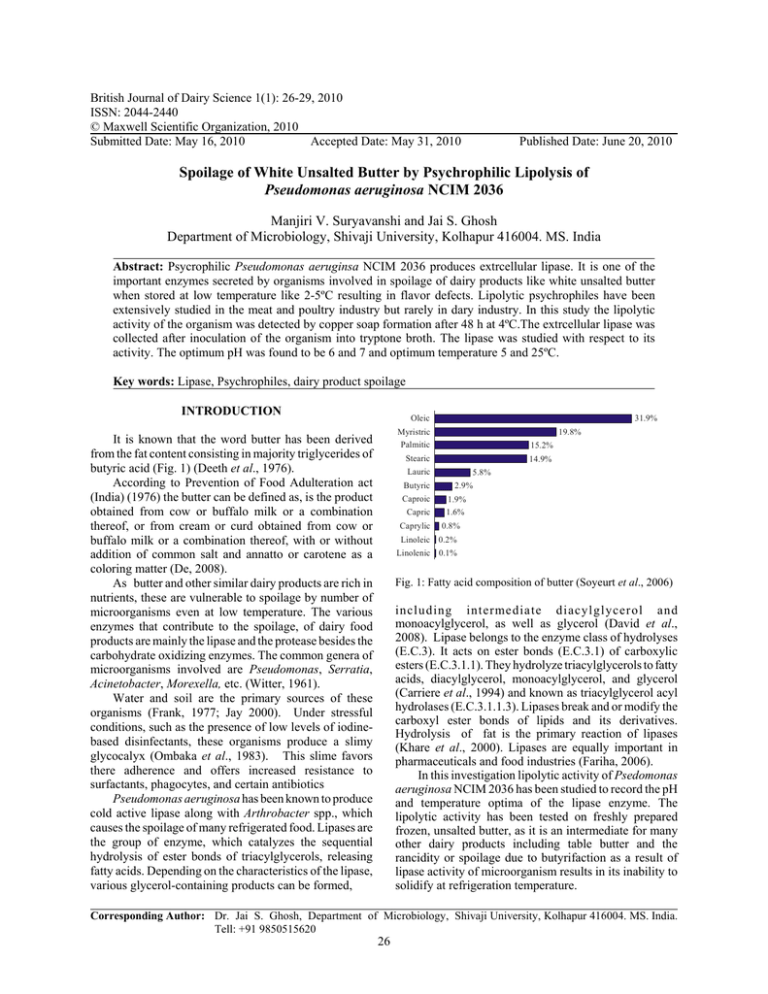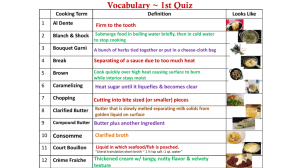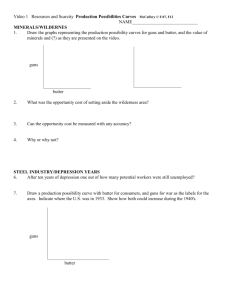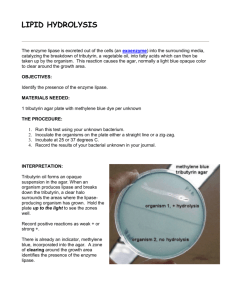British Journal of Dairy Science 1(1): 26-29, 2010 ISSN: 2044-2440
advertisement

British Journal of Dairy Science 1(1): 26-29, 2010 ISSN: 2044-2440 © Maxwell Scientific Organization, 2010 Submitted Date: May 16, 2010 Accepted Date: May 31, 2010 Published Date: June 20, 2010 Spoilage of White Unsalted Butter by Psychrophilic Lipolysis of Pseudomonas aeruginosa NCIM 2036 Manjiri V. Suryavanshi and Jai S. Ghosh Department of Microbiology, Shivaji University, Kolhapur 416004. MS. India Abstract: Psycrophilic Pseudomonas aeruginsa NCIM 2036 produces extrcellular lipase. It is one of the important enzymes secreted by organisms involved in spoilage of dairy products like white unsalted butter when stored at low temperature like 2-5ºC resulting in flavor defects. Lipolytic psychrophiles have been extensively studied in the meat and poultry industry but rarely in dary industry. In this study the lipolytic activity of the organism was detected by copper soap formation after 48 h at 4ºC.The extrcellular lipase was collected after inoculation of the organism into tryptone broth. The lipase was studied with respect to its activity. The optimum pH was found to be 6 and 7 and optimum temperature 5 and 25ºC. Key words: Lipase, Psychrophiles, dairy product spoilage INTRODUCTION Oleic It is known that the word butter has been derived from the fat content consisting in majority triglycerides of butyric acid (Fig. 1) (Deeth et al., 1976). According to Prevention of Food Adulteration act (India) (1976) the butter can be defined as, is the product obtained from cow or buffalo milk or a combination thereof, or from cream or curd obtained from cow or buffalo milk or a combination thereof, with or without addition of common salt and annatto or carotene as a coloring matter (De, 2008). As butter and other similar dairy products are rich in nutrients, these are vulnerable to spoilage by number of microorganisms even at low temperature. The various enzymes that contribute to the spoilage, of dairy food products are mainly the lipase and the protease besides the carbohydrate oxidizing enzymes. The common genera of microorganisms involved are Pseudomonas, Serratia, Acinetobacter, Morexella, etc. (Witter, 1961). Water and soil are the primary sources of these organisms (Frank, 1977; Jay 2000). Under stressful conditions, such as the presence of low levels of iodinebased disinfectants, these organisms produce a slimy glycocalyx (Ombaka et al., 1983). This slime favors there adherence and offers increased resistance to surfactants, phagocytes, and certain antibiotics Pseudomonas aeruginosa has been known to produce cold active lipase along with Arthrobacter spp., which causes the spoilage of many refrigerated food. Lipases are the group of enzyme, which catalyzes the sequential hydrolysis of ester bonds of triacylglycerols, releasing fatty acids. Depending on the characteristics of the lipase, various glycerol-containing products can be formed, 31.9% Myristric Palmitic 15.2% Stearic 14.9% 19.8% Lauric Butyric Caproic Capric Caprylic 5.8% 2.9% 1.9% 1.6% 0.8% Linoleic 0.2% Linolenic 0.1% Fig. 1: Fatty acid composition of butter (Soyeurt et al., 2006) including intermediate diacylglycerol and monoacylglycerol, as well as glycerol (David et al., 2008). Lipase belongs to the enzyme class of hydrolyses (E.C.3). It acts on ester bonds (E.C.3.1) of carboxylic esters (E.C.3.1.1). They hydrolyze triacylglycerols to fatty acids, diacylglycerol, monoacylglycerol, and glycerol (Carriere et al., 1994) and known as triacylglycerol acyl hydrolases (E.C.3.1.1.3). Lipases break and or modify the carboxyl ester bonds of lipids and its derivatives. Hydrolysis of fat is the primary reaction of lipases (Khare et al., 2000). Lipases are equally important in pharmaceuticals and food industries (Fariha, 2006). In this investigation lipolytic activity of Psedomonas aeruginosa NCIM 2036 has been studied to record the pH and temperature optima of the lipase enzyme. The lipolytic activity has been tested on freshly prepared frozen, unsalted butter, as it is an intermediate for many other dairy products including table butter and the rancidity or spoilage due to butyrifaction as a result of lipase activity of microorganism results in its inability to solidify at refrigeration temperature. Corresponding Author: Dr. Jai S. Ghosh, Department of Microbiology, Shivaji University, Kolhapur 416004. MS. India. Tell: +91 9850515620 26 Br. J. Dairy Sci., 1(1): 26-29, 2010 Table 1: Butter agar: Media used for cultivation of organism Butter (%) 1 Yeast extract (%) 0.05 Sodium chloride (%) 0.5 pH 7 Agar (%) 2.5 Table 2: Tryptone broth Media used for production of lipase enzyme from given organism Tryptone (%) 2 Butter (%) 1 Sodium chloride (%) 0.5 pH 7 MATERIALS AND METHODS This work was carried out during the period from June 2009 to march 2010. Organism used for this study is Pseudomonas aeruginosa NCIM 2036. Media used are Butter agar and Tryptone broth. The compositions of these media are as shown in Table 1 and 2. Absorbance (At 253 nm) Fig. 2: Copper soap test showing bluish green zone around colonies indicating a strong lipolytic activity Confirmation of Pseudomonas aeruginosa NCIM 2036.to grow on butter agar at 4ºC: The culture of the organism was inocultated on butter agar plate. The plates were incubated at 4ºC for 7 days. Growth pattern: The organism was inoculated into 100 ml sterile tryptone broth and incubated at 4ºC. At 60 min interval absorbance was measured at 530 nm. 1.2 1.0 0.8 0.6 0.4 0.2 0.0 1 2 3 4 5 6 7 8 9 10 11 12 13 14 15 16 17 18 19 Time (h) Fig. 3: The growth curve of the organism Detection of lipase activity: The culture of Pseudomonas aeruginosa NCIM 2036 was inoculated on butter agar containg butter (unsalted) at 1% concentration and incubated at 4ºC for about 7 days. The lipolytic activity was qualitatively observed by copper soap test (Shirgaokar et al., 2008). The lipolytic activity of culture was further confirmed by GCMS method. Effect of temperature: The optimum temperature of lipase was determined over a range of 0-25ºC by the assay method described above. The culture was further grown in tryptone broth containing butter at same concentration and incubated at 4ºC for 72 h on shaker. This was centrifuged at 5000 rpm. for 10 minutes and the supernatant was precipitated by cold acetone which was then resuspended in 0.10mM phosphate buffer. The protein content was adjusted to 56ug/ml. this was used for further studies. Statistical analysis: All analysis were repeated 5 times i.e., n = 5 with standard deviation less than 10. The calculations were carried out using Graph Pad software (Systat Inc., USA). GCMS of the hydrolyzed butter: Methanolic extract of the hydrolyzed was analyzed by GCMS using standard palmitic, oleic, capric and butyric acid. RESULTS AND DISCUSSION Figure 2 shows that lipolysis shows distinct change in color of the copper sulfate around the colonies. Figure 3 shows that the organism when inoculated in tryptone broth, showed a lag phase for about 3 h. the log phase started from 4th h and persisted for 16 h, followed by stationary phase. Figure 4 shows that the lipase enzyme shows 2 temperature values as optimum. One at 5ºC and the other at 25ºC, which indicates the psychrophilic and mesophilic nature of the activity. Lipolysis assay: The assay was carried out in neutral solvent (prepared by blending equal quantity of diethyl ether and absolute ethanol) using 0.1 mL of the acetone precipate in 1 mL of 10 mM phosphate buffer by titrating against 0.1N KOH using Phenolphthalein as indicator (Plummer, 1971). Effect of pH: The optimum pH of lipolytic activity of the organism was determined over 5 to 9, using 10 phosphate buffer (Abdou and Ohashi, 1996). 27 Enzyme activity (mg of buytric acid mL/h) Br. J. Dairy Sci., 1(1): 26-29, 2010 GCMS analysis: GCMS analysis showed that the product of hydrolysis by psychrophilic lipase gave a mixture of palmitic, oleic, butyric and capric acid (Fig. 7). 0.012 0.010 0.008 DISCUSSION 0.006 0.004 It can be seen from the data that the Pseudomonas aeruginosa NCIM-2036 was capable of producing lipase, which was showing significant activity at 5ºC. David et al. (2008) reported exhaustively about lipolytic spoilage of food material, mostly meat and meat products, by Pseudomonas aeruginosa under refrigerated conditions. However, there are no reports of lipolytic spoilage of dairy products like butter under refrigerated conditions and this has been observed in this study. No lipooxygenase activity was detected at psychrophilic conditions. The most important feature of such lipolytic activity on a product like butter was that the product failed to solidify at a particular temperature. However, due to hydrolysis of the tryglycerides there was a siginificant change in flavor. This was not as per the sensory analysis of “the discriminationg consumer”. Pseudomonas aeruginosa was also producing a mesophilic lipase, which was active at 25ºC. 0.002 0.000 0 5 10 15 Temperature ( OC) 20 25 Enzyme activity (Mg of butyric acid mL/h) Fig. 4: The effect of temperature on lipase activity 0.06 0.05 0.04 0.03 0.02 0.01 0.00 5 6 7 pH 8 9 Enzyme activity (Mg of butyric acid mL/h) Fig. 5: The effect of pH on lipolytic activity at 5ºC 1.00 CONCLUSION 0.08 0.06 This study revealed that a single organism like Pseudomonas aeruginosa could show such a pattern of lipolysis leading to severe economic loss to many dairy industries, which do not take sufficient precaution of proper sanitation and hygiene in handling of a sensitive product like white unsalted butter which often form an intermediate raw material of other dairy products. Though, this is a laboratory study of a single organism, actually in practice there would be other psychrophile like Arthrobacter, Aeromonas etc. which would easily form a consortium, leading to large-scale spoilage. Thus it can be said that during preparation of butter, care has taken to be taken not only to deactivate the native lipase present in the milk but also deactivate and to prevent contamination of the butter with such spoilage microorganisms failing which it may lead to butyrification during storage. 0.04 0.02 0.00 5 7 pH 6 8 9 Fig. 6: the effect of pH on enzyme activity at 25ºC Figure 5 shows that the enzyme has optimum pH value as 7, which is the pH value of washed white butter i.e. free from acids produced during lactic fermentation. Figure 5 and 6 shows that at 5ºC the pH optima is at 7 i.e. at neutral pH value where as at 25ºC it is on the acidic range i.e. 6. This acidic pH of the butter is before washing. (x1,000) 5.0 43 73 129 97 2.5 256 213 157 171 227 281 0.0 50 100 150 200 250 315331 355 389405 429 469486 527 537 300 350 400 450 500 550 Fig. 7: GCMS analysis showing standard mixture of palmitic, oleic, butyric and capric acid 28 Br. J. Dairy Sci., 1(1): 26-29, 2010 Jay, J.M., 2000. Taxonomy, Role and Significance of Microorganisms in Food. In: Modern Food Microbiology. Aspen Publishers, Gaithersburg MD, pp: 13. Ombaka, E.A., R.M. Cozens and M.R.W. Brown, 1983. Influence of nutrient limitation of growth on stability and production of virulence. Factors of mucoid and nonmucoid strains of Pseudomonas aeruginosa. Rev. Infec. Dis., 5: 880. Plummer, D.T., 1971. An Introduction to Practical Biochemistry. 3rd Edn., Tata McGraw Hill publication, Bombay. Khare, S.K., H. Nabetani and M. Nakajima, 2000. Lipase catalyzed interesterification reaction and their industrial applications. Indust, 19: 29-35. Shirgaokar, P.B., P.T. Kumbhar, J.S. Ghosh and S.P. Gpvindwar, 2008. Lipolytic activity of psychrophiles isolated from unsalted butter. J. Microb. World, 10: 118-122. Soyeurt, H., P. Dardenne, A. Gillon, C. Croquet, S. Vanderick, P. Mayeres, C. Bertozzi and N. Gengler, 2006. Variation in fatty acid contents of milk and milk fat within and across breeds. J. Dairy Sci., 89: 4858-4865. Witter, L.D., 1961. Psychrophilic bacteria. A review. J. Dairy Sci., 44: 983-1015. REFERENCES Abdou, A.M. and T. Ohashi, 1996. Behaviour of lipolytic and proteolytic gram negative psycrotrophic bacteria isolated from raw milk, cream and yoghurt in Egypt. Jpn. J. Dairy Food Sci., 45: 97-104. Carriere, F., K. Thirstrup, S. Hjorth and E. Boel, 1994. Cloning of the classical guinea pig pancreatic lipase and comparison with the lipase related protein. FEBS Lett., 338: 63-68. David, A., R. Jorge, C. Fredric, K. Nadia and B. Jacques, 2008. An analytical method for sequential reaction catalysed by same enzyme: Application to the hydrolysis of triglycerol by lipase. J. Biotechnol., 133: 343-350. De, S., 2008. Outlines of Dairy Technology. 28th Edn., Oxford Publisher, New Delhi, pp: 143. Deeth, H.C. and C.H. Fitzgerald, 1976. Lipolysis in dairy products: A review. Aust. J. Dairy Technol., 31: 53-62. Fariha, H., A.S. Aamer and H. Abdul, 2006. Industrial applications of microbial lipases. Enzyme Microb. Tech., 39(2): 235-251. Frank, J.F., 1997. Milk and Dairy Products. In: Doyle, M.P., L.R. Beuchat and T.J. Montville, (Eds.), Food Microbiolog Fundamentals and Frontiers. ASM Press, Washington, pp: 101. 29







